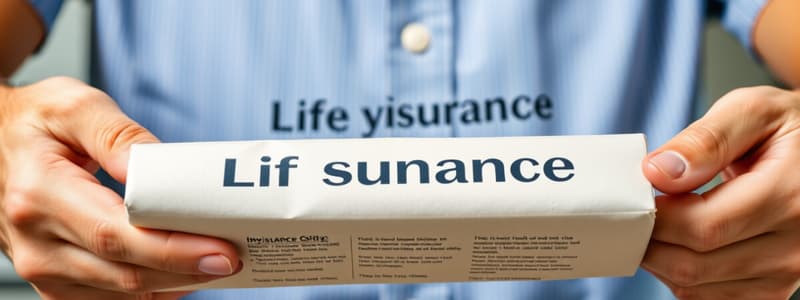Podcast
Questions and Answers
Which of these do NOT constitute policy delivery?
Which of these do NOT constitute policy delivery?
- Policy delivered to the applicant by the agent
- Policy mailed to applicant
- Policy mailed to agent
- Policy issued with a rating (correct)
The underwriting process involves all of these EXCEPT for?
The underwriting process involves all of these EXCEPT for?
- Policy loan (correct)
- Risk classification
- Credit report
- Application
If the application is approved, when will coverage be effective?
If the application is approved, when will coverage be effective?
- The date the application was submitted to the insurance company
- The date the sales appointment was made
- The date the agent delivered the policy, collected the initial premium, and obtained a good health statement from the insured (correct)
- The date of application
What action should Agent J take if the insurance company returns the check made out to him?
What action should Agent J take if the insurance company returns the check made out to him?
An applicant's medical information received from the Medical Information Bureau (MIB) may be furnished to the?
An applicant's medical information received from the Medical Information Bureau (MIB) may be furnished to the?
Information obtained from a phone conversation with the proposed insured can be found in which of these reports?
Information obtained from a phone conversation with the proposed insured can be found in which of these reports?
In order for coverage on a non-medical insurance application to take effect the same day, the producer must collect a signed application and?
In order for coverage on a non-medical insurance application to take effect the same day, the producer must collect a signed application and?
From what authority derives the requirement that an insurance application contains a disclosure stating that an investigative consumer report may be obtained on an applicant?
From what authority derives the requirement that an insurance application contains a disclosure stating that an investigative consumer report may be obtained on an applicant?
P completes an application for a $10,000 life policy, but does not give the producer the initial premium. P's coverage becomes effective when?
P completes an application for a $10,000 life policy, but does not give the producer the initial premium. P's coverage becomes effective when?
Which of the following statements is CORRECT about an agent who is taking an insurance application?
Which of the following statements is CORRECT about an agent who is taking an insurance application?
All of these are considered sources of underwriting information about an applicant EXCEPT?
All of these are considered sources of underwriting information about an applicant EXCEPT?
Which of these actions should a producer take when submitting an insurance application to an insurer?
Which of these actions should a producer take when submitting an insurance application to an insurer?
What is being delivered during a policy delivery?
What is being delivered during a policy delivery?
What action should the producer take if D explains recent health changes after a policy is delivered?
What action should the producer take if D explains recent health changes after a policy is delivered?
Which of these terms accurately defines an underwriter's assessment of information on a life insurance application?
Which of these terms accurately defines an underwriter's assessment of information on a life insurance application?
Flashcards are hidden until you start studying
Study Notes
Policy Delivery
- Policy delivery options include mailing to the applicant, mailing to the agent, and direct delivery by the agent, but issuing a policy with a rating does not constitute delivery.
Underwriting Process
- Key elements in the underwriting process include collecting credit reports, risk classification, and application reviews; however, policy loans are not part of this process.
Effective Date of Coverage
- Coverage for a life insurance policy is effective when the agent delivers the policy, collects the initial premium, and obtains a good health statement from the insured. This can be after the initial application and check submission.
Handling Incorrect Checks
- If a check is made out to the agent rather than the insurance company, the agent must return the check to the applicant and request a new check payable to the insurance company.
Medical Information Bureau (MIB)
- Medical information from the MIB can only be shared with the applicant's physician, not with the agent, spouse, or other entities.
Reports in Underwriting
- Information from phone conversations with the proposed insured is documented in the inspection report.
Non-medical Insurance Coverage
- For non-medical insurance to take effect on the same day, the producer must collect both a signed application and the initial premium, forwarding it to the insurer immediately.
Disclosure Requirement
- The Fair Credit Reporting Act mandates that insurance applications disclose the possibility of obtaining an investigative consumer report on the applicant.
Policy Effectiveness Without Initial Premium
- Coverage for an applicant who does not provide an initial premium becomes effective once they receive the policy and pay the premium.
Application Process and Agent Responsibilities
- Agents should have applicants initial any changes made on the application and avoid asking sensitive questions that may cause embarrassment.
Sources of Underwriting Information
- Common sources for underwriting information include inspection reports and credit reports, while rating services do not count as a source.
Submitting Insurance Applications
- When submitting an insurance application, producers should inform insurers of any relevant information not included on the application, rather than issuing binding receipts without the initial premium.
Policy Delivery Actions
- The action taken during policy delivery involves providing the insurance contract to the proposed insured.
Change in Health Conditions
- If an applicant has a recent change in health, such as seeing a doctor for chest pains, the producer must collect the initial premium along with a signed health statement before delivering the policy.
Risk Classification
- Risk classification is defined as the underwriter's assessment of the information provided in a life insurance application, determining the level of risk the insurer is willing to cover.
Studying That Suits You
Use AI to generate personalized quizzes and flashcards to suit your learning preferences.




